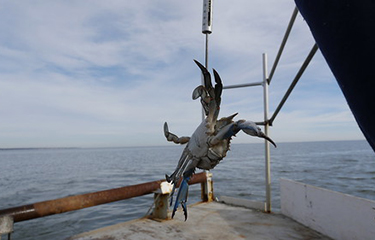A winter survey has shown a promising increase in the blue crab population in the Chesapeake Bay, in the U.S. Mid-Atlantic.
The population rose from 227 million in 2022 to 323 million blue crab in the Bay in 2023, up by 96 million individuals, the survey found. The Virginia Marine Resources Commission (VMRC) and Maryland’s Department of Natural Resources (DNR), which jointly conducted the survey, said 2022 was the worst result they had recorded in the 34 years of the survey, and was down significantly from the all-time high of 852 million crabs reported in 1993.
The low survey numbers resulted in the VMRC and DNR to place limits on crabbers – cutting down the days they could work and instituting catch limits. The restrictions led to a record low catch in 2022.
Crabbers are also reporting early signs of population improvement this spring. They are regularly reporting that they are catching the full 27-bushel daily limit – the reduced limit that was imposed last year, according to both agencies.
Cape Charles, Virginia-based crabber Kenny Heath said he caught his limit on 14 April in a little over a half-day, fishing 250 pots in the Chesapeake Bay.
“We have been catching our limit regularly, and we are encouraged by the number of crabs we are seeing at the start of the season,” he said.
There has been some concern, however, on Virginia’s western shore, as to the slow start of the peeler and soft-shell crab fishery.
“We have had a cooler than normal spring, and the inconsistency in weather has led to inconsistency in crabs,” Lee Walton, a crabber from Urbanna, Virginia, said.
As a result of the positive numbers, a state committee on crab management is recommending increases to crab catch limits in fall and next spring – but is keeping in place the summer reductions, the Virginia Mercury reported.
Since 1990, the survey has utilized traditional crab dredges to sample blue crabs at 1,500 sites throughout the Chesapeake Bay from December through March. By sampling during winter, when blue crabs are sedentary and buried in the mud, scientists can develop more precise estimates of the number of crabs in the Bay.
While the numbers were positive, the report states that although the spawning stock has returned to healthy levels, fisheries managers should remain cautious about the continued trend of low juvenile abundance.
The juvenile populations from 2021 through 2023 rank amongst the six lowest years in the 34 years of the survey. The 2023 adult female abundance of 152 million crabs, however, is promising, though it remains below the target abundance of 196 million crabs, they said.
“We're pleased to see over a 50 percent increase in the adult female numbers in 2023,” VMRC Commissioner Jamie Green said. “These results are encouraging, and we’ll continue working diligently with our partners in the Chesapeake Bay to increase blue crab stock numbers.”
The survey shows that all categories of blue crabs, by sex and by age, have shown an increase since the 2022 survey, including the abundance estimate for all crabs in Chesapeake Bay. Adult crabs drove this increase, with adult males nearly doubling and adult females returning to above-average levels.
According to current biological reference points, female blue crab in the Chesapeake Bay are not overfished, and overfishing is not occurring due to successful management of the bay-wide blue crab fisheries, the report states.
Scientists and managers agree that a robust abundance of adult female crabs is integral to the success of the crab population, as each female can spawn, on average, up to nine million eggs per year. Adult females observed in each survey are likely to spawn during the following early- to mid-summer period, contributing to next year’s juvenile population.
The low abundances in 2022 also spurred interest in a new benchmark stock assessment for blue crabs, allowing researchers to incorporate new data and test new models since the last assessment was conducted in 2011.
This process began in September 2022 with a blue crab science workshop that sought to characterize impacts on the blue crab population from a variety of influences, including water quality, predator abundance, and availability of habitat.
The benchmark stock assessment is scheduled to be completed and peer-reviewed in 2025.
Reporting by Larry Chowning
Photo courtesy of the Maryland Department of Natural Resources







